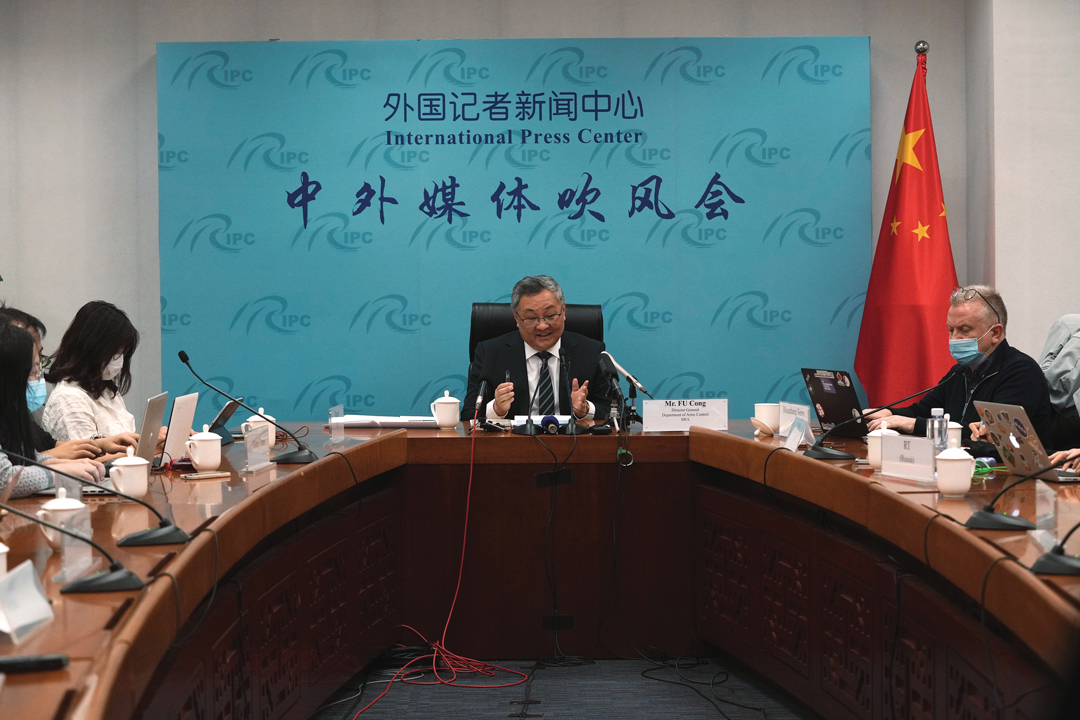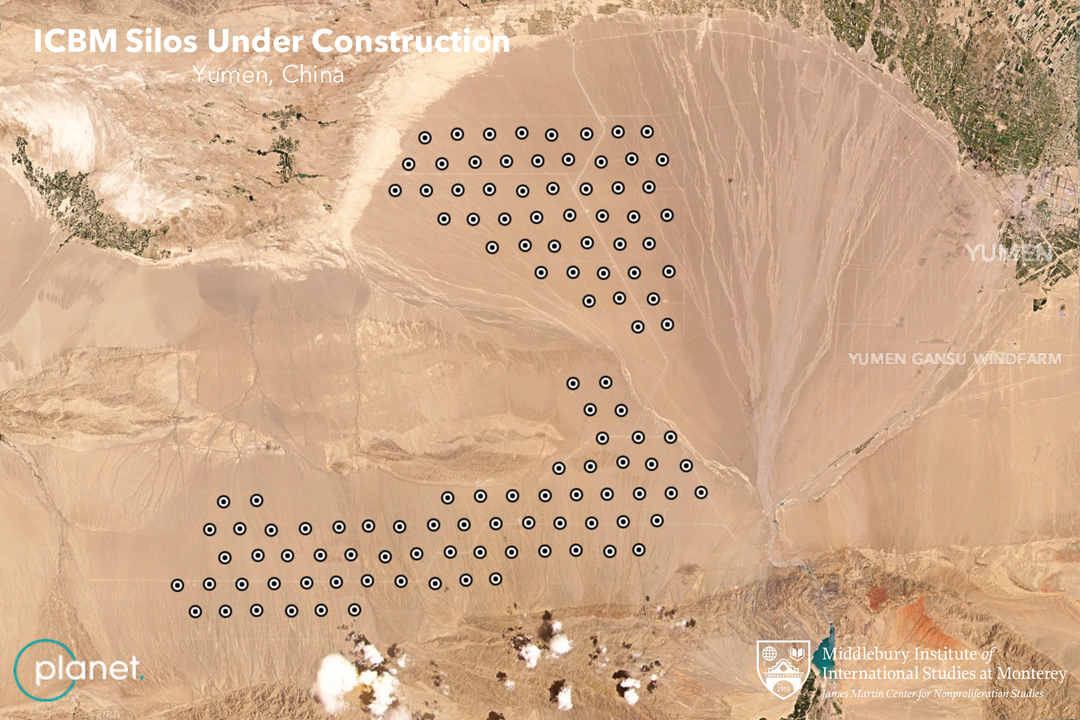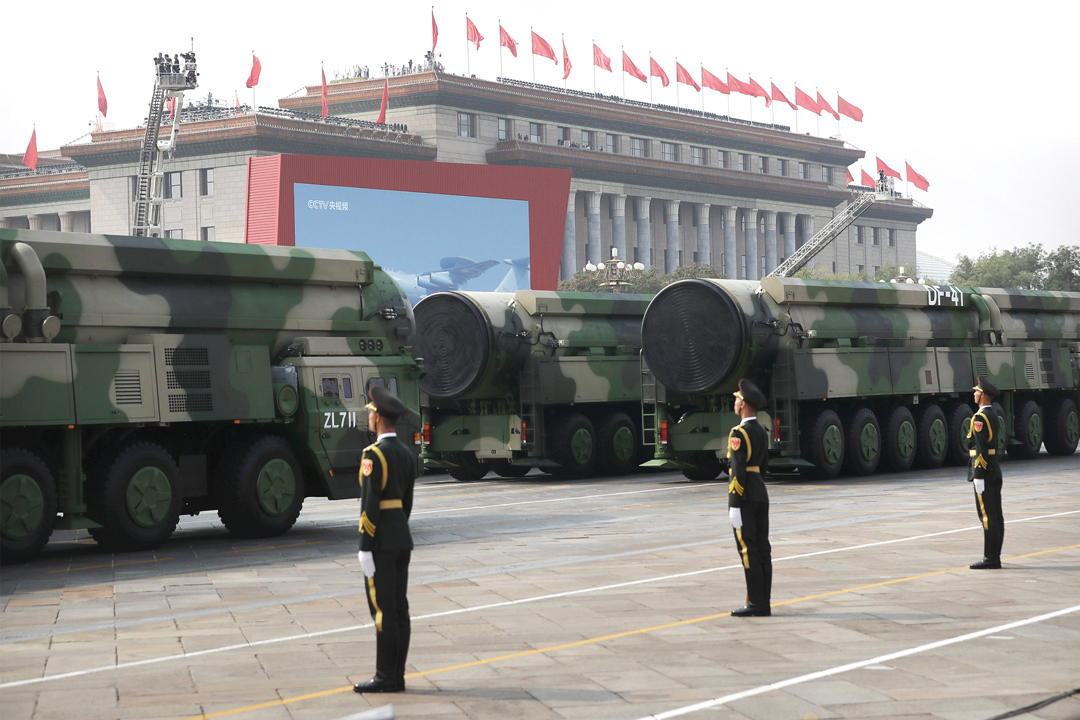An Aggressive Missile Buildup Signals a Significant Policy Shift
By Dr. Brian G. Carlson, head of the Global Security Team at the Center for Security Studies
China’s growing nuclear capacity is a subject of concern for the United States and its allies and partners around the world. Although China’s government denies it, evidence of a large-scale nuclear buildup is accumulating. The motivation for this buildup appears to be a desire among China’s leaders to preserve the credibility of their nuclear deterrent and assert their country’s place in the world. In 2021, satellite images showed that China was constructing about 300 missile silos in western and north-central China that could eventually be filled with intercontinental ballistic missiles (ICBMs). This revelation served as further evidence in support of recent U.S. assessments that China was planning a major expansion of its nuclear arsenal. The 2018 U.S. Nuclear Posture Review argued that China’s nuclear modernization and lack of transparency raised questions about the country’s future intentions. A U.S. Department of Defense report in 2020 projected that during this decade, China would at least double the size of its nuclear warhead stockpile, which the report estimated at the time to be in the low 200s. In August 2021, Adm. Charles Richard, commander of U.S. Strategic Command, which is responsible for U.S. nuclear forces, said China was engaged in conventional and nuclear buildups that were “breathtaking” and constituted a “strategic breakout.” A Pentagon report in 2021 on China’s military raised its estimate of the pace of China’s nuclear buildup, projecting that China could have 700 deliverable nuclear warheads by 2027, and 1,000 warheads by 2030.
The buildup marks a dramatic departure from China’s record over the past several decades. Following its first successful nuclear test in 1964, China adopted the doctrine of minimum nuclear deterrence. This doctrine entailed the renunciation of arms races with other great powers, a declared policy of no first use (NFU) of nuclear weapons and the maintenance of the minimum level of nuclear forces needed to ensure the credibility of China’s nuclear deterrent. With this course, China aimed to protect itself against nuclear threats and blackmail while avoiding the diversion of resources desperately needed for economic development. China adhered to the doctrine of minimum deterrence for several decades after 1964, though it began a gradual modernization of its nuclear arsenal in the 1980s.

By the early 2000s, China most likely possessed only a few dozen nuclear weapons that could strike the U.S., all of which were silo-based, leaving them vulnerable. Since then, China has made significant strides in the modernization of its nuclear forces. It has deployed road-mobile ICBMs, equipped some of its strategic missiles with multiple independently targetable re-entry vehicles (MIRVs), and deployed its navy’s first viable ballistic missile submarines (SSBNs). China also increased the size of its nuclear arsenal, though at least until recently it still appeared to maintain a “lean and effective” nuclear force rather than striving for numerical parity with the U.S. and Russia. For years, China has worried that U.S. missile defense systems, high-precision conventional weapons and nuclear modernization could undermine the credibility of its nuclear deterrent. Until recently, however, Chinese officials believed that they faced no immediate external threat and could respond to these concerns with their own program of gradual nuclear modernization.
This situation appears to have changed in recent years. The 2018 U.S. Nuclear Posture Review raised questions about China’s intentions for its nuclear arsenal despite no change in China’s official doctrine. China’s most recent defense white paper, published in 2019, reaffirms the country’s NFU policy. This document adds that China refrains from engaging in nuclear arms races with other countries and maintains nuclear capabilities at the minimum level required for national security. The goal of the country’s nuclear arsenal, the document states, is to deter other countries from using or threatening to use nuclear weapons against China.

China’s declaratory policies, however, appear to reflect a lack of transparency regarding its actual intentions. Despite the mounting evidence that China is conducting a nuclear buildup of unprecedented size and scope, the Chinese government has remained largely silent on the issue. Official Chinese media sources have disputed Western reporting on the construction of the missile silos, even suggesting that they may instead be windmills. Even many Chinese nuclear experts appear to be in the dark about the silos and about China’s nuclear buildup. Reports of the silo construction first emerged during the summer of 2021, when researchers at the James Martin Center for Nonproliferation Studies at Monterey, California, which is associated with the Middlebury Institute of International Studies, obtained commercial satellite images showing 119 nearly identical construction sites in the desert near Yumen, a city in China’s central Gansu province. According to reporting by The Washington Post, the construction sites had many common features with China’s existing launch facilities for its nuclear-tipped ICBMs. The Middlebury Institute’s Jeffrey Lewis, an expert on China’s nuclear arsenal who was part of the team that analyzed the images, said China would probably deploy the DF-41 ICBM in some of the silos. The DF-41 can carry multiple warheads and has a range of up to 15,000 kilometers, allowing it to reach the U.S. mainland.
Researchers are unsure how many missiles might eventually end up in the silos, however. China has used decoy silos in the past and could use some of the new ones to create uncertainty about the location of its silo-based ICBMs, which could be vulnerable to U.S. counterforce strikes. Additional satellite images showed similar silo construction near Hami in the western province of Xinjiang and near Ordos in Inner Mongolia, for a total of about 300 silos. According to most estimates, China’s current nuclear stockpile most likely is 250 to 350 warheads. Therefore, deploying DF-41s equipped with MIRVs in any significant number of the newly constructed silos would constitute a notable increase in the size of China’s nuclear arsenal.

The U.S. government’s concerns about China’s possible nuclear buildup were growing in the years leading up to the emergence of the satellite images showing the silo construction. In May 2019, Lt. Gen. Robert P. Ashley Jr., then the director of the U.S. Defense Intelligence Agency, predicted that both Russia and China would expand their nuclear arsenals significantly, with China most likely to at least double the size of its nuclear stockpile. The U.S. has sought to involve China in nuclear arms control negotiations, but so far China has refused. Chinese officials argue that the U.S. and Russia should first reduce their nuclear arsenals to levels approaching that of China’s arsenal.
During its final year, the administration of former U.S. President Donald Trump unsuccessfully sought Russia’s assistance in bringing China into a new arms control treaty. In making its case to Russia, the administration shared unprecedented amounts of classified information about China’s nuclear arsenal, including projections of its rapid growth. But Russia declined to apply pressure on China, its strategic partner. U.S. President Joe Biden’s administration has sought to engage China in a dialogue on nuclear issues. However, China has little incentive to join international arms control negotiations. Unlike Russia, which has traditionally viewed international arms control as a means of maintaining nuclear parity with the U.S., China views arms control as a trap that could lock in its nuclear inferiority and stifle its rise.
Russia has also joined China in calling for the U.S. to refrain from deploying land-based intermediate-range missiles in Asia after the demise of the Intermediate-Range Nuclear Forces (INF) Treaty, from which the U.S. withdrew over Russia’s noncompliance. China, which was not a party to the INF Treaty, maintains a large stockpile of INF-range missiles that are at present mostly conventionally equipped.
The Pentagon’s 2021 report on China’s military described its efforts to establish a nuclear triad. In the assessment of the report’s authors, those efforts may have succeeded. The People’s Liberation Army (PLA) is making large investments in, and expanding the number of, its land-, sea- and air-based nuclear delivery platforms and the supporting infrastructure. The report found that the PLA’s Strategic Rocket Force (PLARF), which is responsible for China’s land-based nuclear and conventional missiles, was enhancing its strategic deterrence capabilities.
The PLARF is improving its nuclear-capable missile forces by developing new ICBMs with MIRV capability. The Pentagon report noted the construction of the missile silos and China’s likely intention to use them for the deployment of solid-fueled ICBMs, such as the DF-41. China’s inventory of road-mobile DF-26 intermediate-range ballistic missiles (IRBMs), which have a range that the INF Treaty prohibited the U.S. and Russia from possessing, is also expanding. These missiles, which can avoid detection by satellites, are capable of conducting nuclear precision strikes against ground targets and conventional strikes against naval targets. In 2020, China fielded the DF-17, a medium-range ballistic missile that is capable of mounting the DF-ZF hypersonic glide vehicle (HGV), making this China’s first operational hypersonic weapons system.
The PLA Navy (PLAN) continues to modernize its submarine force. The PLAN has built six Jin-class ballistic missile submarines (SSBNs) of Type 094, which establish China’s first credible sea-based nuclear deterrent. Each of these Jin-class submarines can carry up to 12 JL-2 submarine-launched ballistic missiles (SLBMs). China’s next-generation Type 096 SSBN is expected to carry a new type of SLBM. In the Pentagon’s assessment, construction of the Type 096 SSBN, which will be in operation concurrently with the Type 094, may have begun at the beginning of this decade. By 2030, China could have eight SSBNs. In addition to the improvements in its ground- and sea-based nuclear capabilities, China is also building the airborne leg of its nuclear triad. In October 2019, the PLA’s Air Force (PLAAF) publicly identified the H-6N as its first nuclear-capable air-to-air refuelable bomber. The H-6N can carry an air-launched ballistic missile (ARBM) that may be nuclear capable. China is also developing a stealth bomber that will have a nuclear mission in addition to its conventional role.
China’s motivation for this nuclear buildup appears to reflect specific concerns about the country’s nuclear deterrent and a broader desire to ensure that China has sufficient military power to command respect at a time of growing competition among the world’s great powers. Lewis, the Middlebury Institute’s expert, argues that one of China’s primary objectives in building the missile silos for likely DF-41 deployments is to maintain the credibility of its nuclear deterrent. China aims to ensure that its nuclear forces could survive a U.S. first strike in sufficient numbers to launch a retaliatory strike that could overcome U.S. missile defense systems.

Chinese nuclear experts also cite the ongoing U.S. program of nuclear modernization as a reason to expand China’s nuclear arsenal. The U.S. modernization program aims to upgrade nuclear weapons and delivery systems over the next two decades. Some U.S. delivery systems, including Minuteman ICBMs, have been in service for decades. However, Chinese nuclear experts argue that U.S. nuclear modernization, combined with the development of missile defense systems and high-precision conventional weapons, threaten the credibility of China’s nuclear deterrent. Lewis argues that U.S. missile defense and investments in new systems that include an air-launched cruise missile and at least two new types of warheads, are driving China’s concerns.
Tong Zhao, a senior fellow at the Carnegie Nuclear Policy Program, argues that Chinese leaders believe Western countries feel threatened by China’s rise and now seek to demonize and contain it. The U.S. has identified strategic competition with China as one of the country’s foremost national security challenges in the years ahead, and China’s tensions with the West have been rising on issues such as human rights, democratic values, the rule of law and international norms. According to Zhao, Chinese leaders have concluded that their only option is to consolidate their country’s power to force Western countries to come to terms with China’s strength. An expansion of China’s nuclear arsenal appears to be an important part of this effort. Chinese President Xi Jinping, who has consolidated his own personal power to an extent that comes close to one-man rule, has made statements in support of this objective. Shortly after coming to power in 2012, he emphasized the importance of the Second Artillery Corps, as the PLA’s missile branch was then known. China later upgraded this branch to a full military service and renamed it the Rocket Force. In March 2021, Xi instructed the PLA to “accelerate the construction of advanced strategic deterrent” capabilities.
Like the Soviet Union during the Cold War, China may now believe that building a strong nuclear force is the only way to achieve political equality with the U.S. In this view, only a strong Chinese military, including a powerful strategic nuclear force, can force the U.S. and other Western countries to abandon their hostility toward China. Zhao identifies worrying signs of a lack of meaningful dialogue on these issues between the U.S. and China, which could lead to a destabilizing nuclear arms race and eventually a dangerous confrontation similar to the Cuban missile crisis.
China’s nuclear buildup raises crucial questions about its ultimate purpose. Michael Chase, U.S. deputy assistant secretary of defense for China, wrote in 2019 that several potential pathways lay ahead for China’s nuclear policies. First, China could choose to focus exclusively or almost exclusively on assured retaliation. On this pathway, China would most likely adhere to the strategy outlined in its official documents, including NFU, and would probably deploy 300-400 nuclear warheads within the next 10-15 years. Second, China could shift toward “assured retaliation plus.” If China were to choose this pathway, then it would aim for assured retaliation plus some more flexible options, at least at the regional level. China might adopt a conditional NFU policy that would lower the nuclear threshold to try to deter conventional attacks against strategic targets. This pathway could entail the deployment of 500-800 nuclear warheads over the next 10-15 years, but most likely without the deployment of tactical nuclear weapons. Third, China could seek nuclear parity with the U.S. and Russia. On this pathway, China would abandon NFU and develop warfighting capabilities. It would deploy 1,000 or more nuclear warheads and might also deploy tactical weapons. The recent evidence suggests that China is pursuing at least the second pathway, and the possibility that it would eventually choose the third pathway cannot be excluded.


Comments are closed.